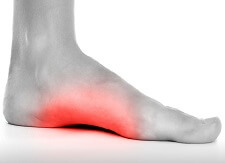- Home
- Diagnosis Guide
- Toe Pain
- Claw Toe
Claw Toe
Written By: Chloe Wilson BSc(Hons) Physiotherapy
Reviewed By: FPE Medical Review Board
Claw toe is a foot problem where one or more of the toes bend and curl into an abnormal position. This can be quite painful and make walking difficult.
It is typically caused by ill-fitting footwear, genetics, muscle imbalance and abnormal foot biomechanics.
Claw toe is a common type of toe deformity, similar but distinctly different to hammer toe and mallet toe.
Here we look at what claw toe is, the common causes and symptoms, how it is diagnosed and the best treatment options. You can also find answers to the most frequently asked questions about claw toes.
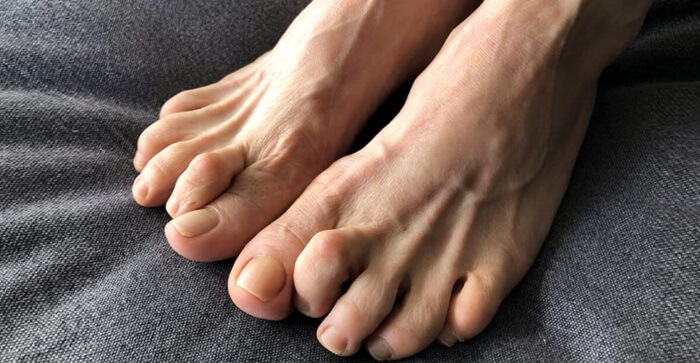
What is Claw Toe?
Claw toe is a foot deformity where the toes bend abnormally into a claw-like shape. In a normal toe, there are three joints that are flexible and move smoothly, allowing the toe to lay flat or follow the natural contour of the foot. They are:
- MTP Joint: Metatarsophalangeal joint, between the ball of the foot and the start of the toes (similar to your knuckles)
- PIP Joint: Proximal interphalangeal joint, the middle toe joint
- DIP Joint: Distal Interphalangeal Joint, the end joint near the tip of the toe
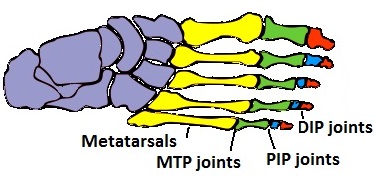
With claw toe, the middle and end toe joints (PIP & DIP) bend forwards, curling the toe downwards. To compensate, the first toe joint (MTP) bends backwards (hyperextends). This causes the toe to resemble a claw.
Claw toe deformity can affect any of the smaller toes often involving multiple toes, it doesn’t however affect the big toe.
The deformity can be either:
- Flexible Claw Toe: where the toe can still be manually straightened
- Rigid Claw Toe: where the toe is fixed in its abnormal position and cannot be realigned without surgical intervention
If left untreated, claw toe can progress from a flexible deformity to a rigid one over time, leading to pain, difficulty walking, and secondary problems like corns and calluses due to increased pressure on certain parts of the toe.
Claw Toe vs. Other Toe Deformities
Claw toe is often confused with other toe deformities like hammer toe and mallet toe, but there are subtle differences:
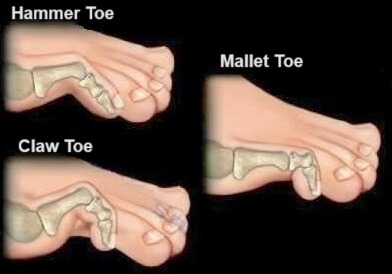
- Hammer Toe: Involves an abnormal bend downwards in the middle joint of the toe, while the joints above and below (MTP & DIP) bend backwards into hyperextension. Typically only affects one toe
- Mallet Toe: Involves a downward bend at the tip of the toe, without the involvement of the middle joint. Most common in the second toe.
- Bunions: Where the big toe deviates inwards towards the second toe aka hallux valgus.
While these conditions may share some symptoms, their treatment can differ, making accurate diagnosis important.
What Causes Claw Toes?
There are several potential causes of claw toe, including:
- Muscle Imbalance: The most common cause is an imbalance between the muscles that flex the toes and those that extend them. This imbalance causes the tendons and ligaments in the toes to pull the joints into an abnormal position. Muscle imbalance can be caused by underlying conditions like flat feet or high arches, which alter the way weight is distributed across the foot, as well as muscle tightness and weakness.
- Footwear: Wearing shoes that are too tight, especially ones that force the toes into a cramped position, e.g. a narrow toe box or high heels, can compress the toes into an unnatural position. Over time, this constant pressure may cause the toes to remain in a bent position, eventually leading to claw toe. Women who frequently wear high heels or pointed shoes are at higher risk.
- Neurological Conditions: Conditions like diabetes, cerebral palsy, charcot-marie-tooth disease and stroke can damage the nerves and muscles in the feet, leading to claw toe.
- Trauma: Past injuries to the foot or toe, like a sprain, fracture or dislocation, can cause damage to the ligaments and tendons supporting the toes. If these injuries are not properly treated, they may heal in a way that predisposes the toe to clawing.
- Rheumatoid Arthritis: This autoimmune condition can damage the joints and tissues in the feet, making the toes more susceptible to deformities like claw toe.
- Genetics: Some people may have a genetic predisposition to foot deformities, including claw toe, due to the structure of their feet. This includes individuals with abnormally high arches, longer toes, or congenital foot deformities.
- Age: As we age, the likelihood of developing claw toe increases, partly due to weakening muscles and wear and tear on the joints.
Symptoms of Claw Toe
Claw toe presents with both visual and functional symptoms, which can vary depending on the severity of the deformity:
Common symptoms include:
- Toe Deformity: The most noticeable symptom of Claw Toe is the abnormal appearance of the toes. The toe curls downward, giving the toe a claw-like appearance. The abnormal curvature may be more pronounced in severe cases.
- Pain and Discomfort: Many people with claw toes experience pain, especially when walking or wearing shoes. This pain is often localized to the bent joints but there may also be ball of foot pain, where the toe pushes downward into the shoe.
- Corns and Calluses: The abnormal position of the toe can lead to rubbing against footwear, resulting in painful corns or calluses on the top of the toe or under the ball of the foot.
- Swelling and Redness: The toe joints may become inflamed due to friction with shoes, leading to swelling, redness, and irritation around the affected area.
- Stiffness: Initially, claw toes may remain flexible, but over time they can become rigid, making it harder to move the affected toes. In time, there may be permanent deformity that can only be corrected with surgery.
- Difficulty Walking: As claw toes progress, they can interfere with your ability to walk properly, particularly if multiple toes are affected. The discomfort can alter your gait, potentially causing strain on other areas of the foot and lower body.
Diagnosis of Claw Toe
Diagnosing claw toes generally involves a thorough physical examination by a healthcare professional, such as a podiatrist or orthopedic specialist. The steps to diagnosis typically include:
- Visual Examination: Your doctor will visually inspect the affected foot, noting the position of the toes and any signs of corns, calluses, or swelling.
- Range of Motion Tests: During the exam, your doctor may assess the flexibility of the toes by moving them up and down. This helps determine whether the deformity is still correctable (flexible) or if it has become fixed (rigid).
- Gait Analysis: They may also observe how you walk to assess how the deformity is affecting your overall foot function and weight distribution.
In some cases, further testing may be necessary, including:
- X-rays: X-rays can provide a clearer picture of the bones and joints involved. They are particularly useful in determining the severity of the deformity and in ruling out other possible causes of toe deformities, such as fractures or arthritis.
- Electromyography (EMG) or Nerve Conduction Studies: If a neurological condition is suspected, these tests can assess the health of the muscles and nerves controlling the foot.
- Blood Tests: If rheumatoid arthritis or another systemic condition is suspected as the underlying cause, blood tests may be ordered to check for inflammatory markers or autoimmune activity.
#CommissionEarned from Amazon on qualifying purchases
Claw Toe Treatment
Treatment for claw toe will depend on the severity of the condition and whether the toes are still flexible. The primary goals of treatment are to alleviate symptoms, correct the deformity (if possible), and prevent further progression. Here are the most common claw toe treatment options:
1. Footwear Modifications
One of the simplest and most effective ways to manage claw toe is to switch to properly fitting shoes. Shoes with a wide toe box and soft upper material reduce pressure on the toes. Shoes with adequate arch support can also help by improving overall foot mechanics.
2. Toe Exercises
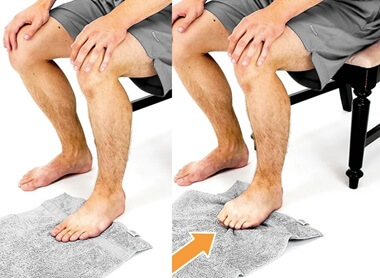
In the early stages, stretching and strengthening exercises can help improve the flexibility and alignment of the toes. Common exercises include:
- Toe Towel Curls: Lay a towel flat on the floor, and use your toes to scrunch it up. This strengthens the muscles in the foot and toes.
- Toe Extensions: Gently pull each toe back into a straight position and hold for a few seconds. This can help improve flexibility.
3. Orthotic Devices
Custom-made orthotics, such as arch supports or metatarsal pads, can be placed inside your shoes to redistribute pressure and support the foot’s natural structure, preventing further deformity and improving the overall function of the foot. They also help reduce foot pain when walking.
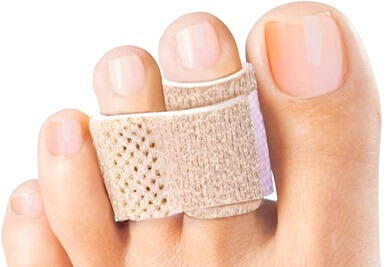
Toe Splints help hold the toes in a more natural position and reduce friction between the toes and footwear.
Silicone caps can also cushion the toes and protect them from developing corns or calluses.
Using pads or tape to cushion the affected toes can also reduce friction and pain caused by rubbing against shoes, and reduce the risk of developing secondary problems such as corns & calluses.
4. Medications
Over-the-counter pain relievers, such as paracetamol/acetaminophen or non-steroidal anti-inflammatory drugs (NSAIDs) such as ibuprofen/Advil, can help manage pain and inflammation. In some cases, your doctor may recommend corticosteroid injections to reduce inflammation in severe cases.
5. Surgical Treatments
If non-surgical treatments aren’t effective or if the deformity has become rigid, surgery may be recommended. Common surgical procedures for claw toe include:
- Tendon Lengthening or Transfer: In mild-moderate cases, the tendons in the affected toes may be surgically lengthened or transferred to restore balance between the muscles that flex and extend the toes. This allows the toe to return to its natural position.
- Joint Fusion: In more severe or rigid cases, surgical fusion of the joints may be necessary. This involves removing part of the joint and realigning the bones so they heal in a corrected position. While this permanently stiffens the joint, it eliminates the pain and discomfort associated with claw toe.
- Bone Removal: In some cases, the tip of the bone may be removed to straighten the toe and prevent it from curling downward. This is a common procedure for patients with rigid deformities and is aka Phalangeal Head Resection
Recovery from surgery typically requires several weeks of limited activity. You may need to wear a post-operative shoe or walking boot to protect the foot during healing. Physical therapy is usually recommended to restore strength, flexibility, and function to the foot.
Claw Toes FAQ's
1. Can You Prevent Claw Toe?
1. Can You Prevent Claw Toe?
To reduce the risk of developing claw toe or to prevent the condition from worsening, consider the following tips. Always wear shoes that fit well and have a wide toe box to prevent crowding the toes. Regular foot exercises can help keep the muscles in your feet and toes strong and balanced. If you have a condition like diabetes or rheumatoid arthritis, managing it properly can help reduce the risk of foot deformities.
2. Is Claw Toe Reversible?
2. Is Claw Toe Reversible?
In the early stages, when the toe is still flexible, claw toe can often be reversed or significantly improved with non-surgical treatments like stretching exercises, proper footwear, and orthotics. However, if the deformity becomes rigid, it can only be reversed with surgery to correct the toe's position.
3. What Age Do People Get Claw Toes?
3. What Age Do People Get Claw Toes?
Claw toe can develop at any age but is more common in adults, particularly those over 50. Aging contributes to muscle weakness and joint problems, increasing the likelihood of developing claw toe. It can also appear in younger individuals with specific risk factors like foot trauma or neurological conditions.
4. Does Walking Barefoot Help Claw Toes?
4. Does Walking Barefoot Help Claw Toes?
Walking barefoot can be beneficial for strengthening the muscles in the feet, potentially slowing the progression of claw toe in its early stages. However, it may not reverse the deformity once it has developed, and in some cases, walking barefoot may exacerbate pain, especially if the toe is rigid or there are corns and calluses.
5. What Does Claw Toe Look Like?
5. What Does Claw Toe Look Like?
Claw toe often resemble a clench fist with bent and curled toes. The middle and end joints of the toe bend and curl downward, while the joint closest to the foot bends backwards to compensate, creating a claw-like appearance. The affected toes may sit higher than normal, and corns or calluses may develop where the toes rub against shoes. The deformity usually affects the second, third, or fourth toes.
6. How Common Is Claw Toe?
6. How Common Is Claw Toe?
Claw toe affects around 2-9% of the population, most typically between the ages of 60-80. It is 4-5x more common in women than men. It is more prevalent in people with diabetes, affecting 32-46% of diabetics. Claw toe is less common than other toe deformities such as hammer toe and mallet toe.
Summary
Claw toe is a progressive foot condition that, while potentially painful and limiting, can be managed or even corrected with early intervention. Whether through simple lifestyle changes, non-surgical treatments, or surgery, the goal is to maintain foot function and reduce pain.
By paying attention to your foot health and seeking professional guidance when needed, you can take steps to prevent claw toe from becoming a long-term issue that impacts your mobility and comfort.
Claw toe is just one possible type of toe deformities, others including hammer toe, mallet toe and bunions.
You may also be interested in the following articles:
Related Articles
References
- Lesser Toe Deformities. NHS Lanarkshire
- Claw Toe Deformity. Radiopaedia
- Treatment of Dynamic Claw Toe Deformity Through Lengthening of the Flexor Tendons of the Hallux and Toes at the Midfoot Level. Foot & Ankle Specialist
- Role of Intrinsic Muscle Atrophy in the Etiology of Claw Toe Deformity in Diabetic Neuropathy May Not Be as Straightforward as Widely Believed. Diabetes Care.
Page Last Updated: 7th October, 2024
Next Review Due: 7th October, 2026
